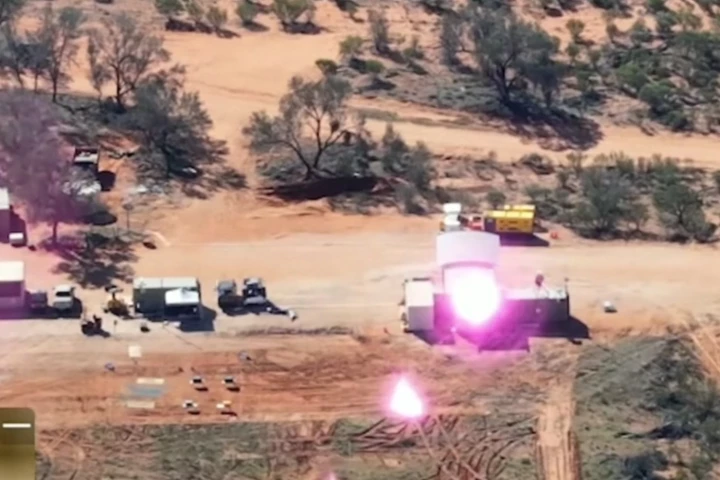Ultra-deep tech startup Nirvanic put on a fairly humble-looking robotics demo at Jeff Bezos's private MARS 2025 conference – and while the team is adamant that this implies no endorsement from Bezos or Amazon, it may go down as a landmark moment both in AI robotics, and in our understanding of consciousness itself.
We're going to some strange places with this one, folks, so I'm compelled to point out from the very beginning that Nirvanic is a legit company, founded by one of the most remarkable innovators I've run across in 20-odd years of technology journalism.
British-born Canadian Suzanne Gildert started her remarkable career with a Ph.D in Experimental Quantum Computing and several years creating quantum AI algorithms for D-Wave. She then co-founded Kindred AI, working on industrial AI robotics, and did rather well with that, leading to the third-largest exit in Canadian robotics startup history at a third of a billion Canadian dollars. Next, she co-founded Sanctuary AI, where she also served as CTO through the development of one of the world's most advanced humanoid robots, Phoenix:
Introducing: Phoenix™ Gen 7
— Sanctuary AI (@TheSanctuaryAI) April 25, 2024
Major improvements, all delivered in less than a year. Our next generation of general-purpose technology marks an inflection point in task automation velocity.
“With Generation 7, we can capture increasing quantities of higher quality, higher… pic.twitter.com/gZtl307oKw
Last year, she left Sanctuary to found Nirvanic, with an outrageously ambitious mission: "to engineer consciousness technologies."
Specifically, Gildert believes the current technology landscape provides the perfect chance to test the theory of quantum consciousness – the idea that consciousness itself arises in the brain due to quantum effects like entanglement and superposition. That these effects provide the spark of self-aware experience, as well as the opportunity for sentient beings to inject free will into a decision, where the rest of the brain would appear to look much more like a deterministic computer algorithm.
As we explored in the article linked above, this 30-something-year-old theory has long been derided as pseudoscience – but it's found some validation in recent experiments that have indicated it's not only possible for quantum effects to arise in the hot, wet, continually moving and sloshy environment of the human brain – but that there's some evidence that they're happening.
Here's Gildert speaking with one of the original authors of the quantum consciousness theory, Dr. Stuart Hameroff, who was in attendance at the MARS 2025 conference.
Gildert believes that sentience is the missing link that'll enable the next great leap in AI robotics – the ability to shift from a kind of unconscious "I've seen this before, I know what to do" mode into a much more aware and creative, "conscious" problem-solving mode that takes over when a robot sees a situation that's way outside the scope of what it's seen in training data.
And while quantum consciousness is still extremely 'out there' as scientific theories go, Gildert tells me over a video call that it's an ideal entry point for anyone serious about doing some practical, experimental research and development into the biggest mysteries of the mind.
"Most theories of consciousness have no proposed experiments," she tells me. "If you're serious about doing science, quantum consciousness is actually a great place to start – because it's falsifiable. Say you're super skeptical. Great. Then help rule it out! If you want to understand consciousness, this is the theory you can actually poke at with experiments."
Amazing things start to happen when we follow our intuition and curiosity. We make discoveries. We face roadblocks. We innovate solutions. Follow our journey to engineer conscious robotics. Join our Substack. 👇https://t.co/FsmI1Lbnwp
— Nirvanic Consciousness Technologies (@NirvanicAI) April 12, 2025
Photos by Ben Rose Photography from… pic.twitter.com/D60OGPMu2r
Nirvanic's groundbreaking "Spark of Life" demonstration in Florida
The experiments Gildert has in mind start out fairly simply: by putting today's quantum computing chips in the control loop of simple robots, interacting with the traditional silicon circuits that run their AI control algorithms. And that's exactly what Nirvanic demonstrated, live on stage at the MARS conference, in a very basic "Kit Kat" robot setup that put cloud-based quantum processing into the control loop.
“We had a small quadruped robot on a table on stage," says Gildert. "It had a webcam for perception data, which it would send off to a D-Wave quantum computer on the west coast of Canada. The quantum code would process the input, collapse the wave function, and send back a chosen action – and then the robot would move. This loop was happening about twice a second.
"It was taking webcam frames and extracting features," she explains, "feeding that into a quantum state, collapsing it to select an action, and feeding that action back to the robot. It had 32 possible action options – that number came from 5 qubits encoding binary strings, two to the power of five."
At the core of @NirvanicAI's theory of quantum conscious agency, is a key postulate: unconscious decisions use classical physics, and conscious decisions use quantum. This summer, we are testing this theory by creating a "quantum brain" for a robot, connecting our quantum… pic.twitter.com/HPZ571iXZp
— Nirvanic Consciousness Technologies (@NirvanicAI) April 10, 2025
To be clear, this work is at an incredibly early stage. "I’m not claiming this robot is conscious," Gildert tells me, "not yet. But this is the experimental test platform. It lets us start looking for signatures of consciousness. If we shape the quantum state correctly, could we see a behavioral pattern that’s different to a classical system?"
"We call it the ‘Spark of Life’ experiment," she explains. "We’re checking: does a quantum-controlled robot behave differently than a classical one in statistically significant ways? If it does, that’s a thread to pull on."
So while the robot on stage in Florida may not have done anything particularly amazing, this demo could well go down as a historic moment in human technology, depending on where Nirvanic's research program goes from here, and what this work ends up discovering about the experiencing mind, or the advantages quantum processing might bring to the robotics field.

How Nirvanic plans to find the ghost in the machine
For now, Nirvanic is preparing to get into the first stages of its research program. What will that look like?
"You run the same setup in classical simulation mode and quantum mode," says Gildert, "collect a million examples of action choices, and compare the distributions. If the quantum version consistently prefers some actions over others in ways the classical one doesn’t, we might be seeing something interesting.
"If we see a difference, the next step is to amplify it," she explains. "To use that behavioral quirk in a reinforcement learning loop. If it learns faster with the quantum system in the loop, now we’ve got something we can turn into a real technology."
Nirvanic has been set up with some remarkable goals in mind. Through this kind of experimentation, the company aims to explore, validate or falsify the theory of quantum consciousness – but also to develop and commercialize practical quantum computing tech along the way that can advance the fields of AI and robotics.
And it could be just the shot in the arm that quantum computers need, too.
"Honestly, I still don’t think quantum computers have found good applications yet," says Gildert. "Everyone talks about factoring RSA or simulating molecules, but we’re still waiting for the ‘killer app ...' I like to compare it to the early days of GPUs: all this cool hardware, but no games to run on it yet. Quantum’s like that. If consciousness turns out to need quantum computation … That’s our game."
If consciousness does turn out to be a quantum phenomenon, Gildert says this could be an enormous ethical advantage moving into an age of sentient robotics – because it'll be clear exactly when the conscious and unconscious parts of the robot mind are engaged.
"I hope it turns out to be quantum," she tells me, "because then at least there’s a switch. If consciousness only emerges when you plug in the quantum system, it gives us a boundary we can work with, and ethical clarity too."
Enjoy our full interview – one of the most remarkable conversations I've had in the last 20 years – in audio podcast format on Spotify:
Or check it out on YouTube in the video below.







